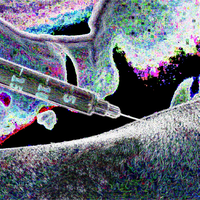| Pyrrolidine | |
|---|---|
| Salts [] | |
|---|---|
| %!s( | |
| Molecular structure via molpic based on CDK |
| Physical properties [] | |
|---|---|
| Molecular mass | 71.12 g/mol [1] |
| Density | 0.8520 at 22.5 °C/4 °C g/cm3 [1] |
| Appearance | Colorless to pale yellow liq [1] |
| Odor | Unpleasant, ammoniacal odor [1] |
| Taste | POWERFUL, AMMONIACAL TASTE [1] |
| Melting point | -57.79 °C [1] |
| Boiling point | 86.56 °C [1] |
| Decomposition | When heated to decomposition it emits highly toxic fumes of /nitrogen oxides/. [1] |
| Solubility | Soluble in ethanol, ethyl ether; slightly soluble in benzene, chloroform [1] |
| Predicted LogP | 0.5 [1] |
| Structural Identifiers [] | |
|---|---|
| Molecular formula | C4H9N [1] |
| IUPAC name | pyrrolidine [1] |
| SMILES | C1CCNC1 [1] |
| InChI | InChI=1S/C4H9N/c1-2-4-5-3-1/h5H,1-4H2 [1] |
| InChIKey | RWRDLPDLKQPQOW-UHFFFAOYSA-N [1] |
Pyrrolidine
Pyrrolidine (also known as Tetrahydropyrrole, Azacyclopentane, Azolidine, Tetramethylenimine, Butylenimine, Perhydropyrrole, Prolamine, 1-Azacyclopentane, Pyrrolidine ring or Pyrrole, tetrahydro-) is a
Chemistry
Salts []
Pyrrolidine is typically found in the form of its hydrochloride salt.
Stereochemistry []
Pyrrolidine is a achiral mixture
See also []
External links []
References []
National Center for Biotechnology Information. PubChem Compound Summary for CID 31268, Pyrrolidine. Accessed July 19, 2025. https://pubchem.ncbi.nlm.nih.gov/compound/31268
U.S. Food and Drug Administration; National Center for Advancing Translational Sciences. Pyrrolidine. UNII: LJU5627FYV. Global Substance Registration System. Accessed July 19, 2025. https://gsrs.ncats.nih.gov/ginas/app/beta/substances/LJU5627FYV
 Anodyne
Anodyne